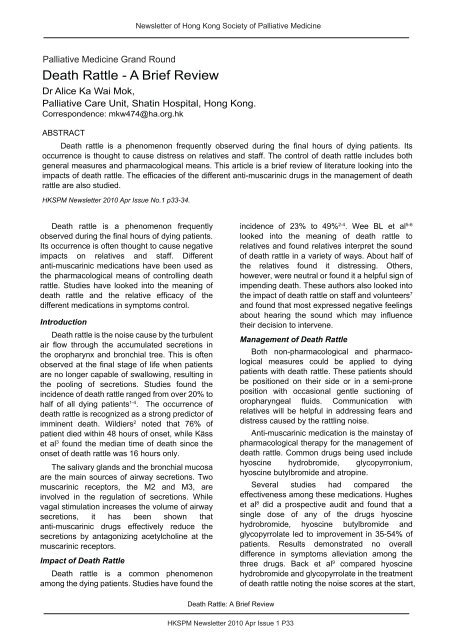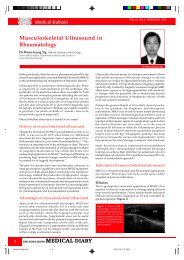Death Rattle - A Brief Review
Death Rattle - A Brief Review
Death Rattle - A Brief Review
Create successful ePaper yourself
Turn your PDF publications into a flip-book with our unique Google optimized e-Paper software.
Palliative Medicine Grand Round<br />
<strong>Death</strong> <strong>Rattle</strong> - A <strong>Brief</strong> <strong>Review</strong><br />
Dr Alice Ka Wai Mok,<br />
Palliative Care Unit, Shatin Hospital, Hong Kong.<br />
Correspondence: mkw474@ha.org.hk<br />
ABSTRACT<br />
<strong>Death</strong> rattle is a phenomenon frequently observed during the final hours of dying patients. Its<br />
occurrence is thought to cause distress on relatives and staff. The control of death rattle includes both<br />
general measures and pharmacological means. This article is a brief review of literature looking into the<br />
impacts of death rattle. The efficacies of the different anti-muscarinic drugs in the management of death<br />
rattle are also studied.<br />
HKSPM Newsletter 2010 Apr Issue No.1 p33-34.<br />
<strong>Death</strong> rattle is a phenomenon frequently<br />
observed during the final hours of dying patients.<br />
Its occurrence is often thought to cause negative<br />
impacts on relatives and staff. Different<br />
anti-muscarinic medications have been used as<br />
the pharmacological means of controlling death<br />
rattle. Studies have looked into the meaning of<br />
death rattle and the relative efficacy of the<br />
different medications in symptoms control.<br />
Introduction<br />
<strong>Death</strong> rattle is the noise cause by the turbulent<br />
air flow through the accumulated secretions in<br />
the oropharynx and bronchial tree. This is often<br />
observed at the final stage of life when patients<br />
are no longer capable of swallowing, resulting in<br />
the pooling of secretions. Studies found the<br />
incidence of death rattle ranged from over 20% to<br />
half of all dying patients1-4 . The occurrence of<br />
death rattle is recognized as a strong predictor of<br />
imminent death. Wildiers2 noted that 76% of<br />
patient died within 48 hours of onset, while Käss<br />
et al3 found the median time of death since the<br />
onset of death rattle was 16 hours only.<br />
The salivary glands and the bronchial mucosa<br />
are the main sources of airway secretions. Two<br />
muscarinic receptors, the M2 and M3, are<br />
involved in the regulation of secretions. While<br />
vagal stimulation increases the volume of airway<br />
secretions, it has been shown that<br />
anti-muscarinic drugs effectively reduce the<br />
secretions by antagonizing acetylcholine at the<br />
muscarinic receptors.<br />
Impact of <strong>Death</strong> <strong>Rattle</strong><br />
<strong>Death</strong> rattle is a common phenomenon<br />
among the dying patients. Studies have found the<br />
Newsletter of Hong Kong Society of Palliative Medicine<br />
<strong>Death</strong> <strong>Rattle</strong>: A <strong>Brief</strong> <strong>Review</strong><br />
HKSPM Newsletter 2010 Apr Issue 1 P33<br />
incidence of 23% to 49% 2-4 . Wee BL et al 5-6<br />
looked into the meaning of death rattle to<br />
relatives and found relatives interpret the sound<br />
of death rattle in a variety of ways. About half of<br />
the relatives found it distressing. Others,<br />
however, were neutral or found it a helpful sign of<br />
impending death. These authors also looked into<br />
the impact of death rattle on staff and volunteers 7<br />
and found that most expressed negative feelings<br />
about hearing the sound which may influence<br />
their decision to intervene.<br />
Management of <strong>Death</strong> <strong>Rattle</strong><br />
Both non-pharmacological and pharmacological<br />
measures could be applied to dying<br />
patients with death rattle. These patients should<br />
be positioned on their side or in a semi-prone<br />
position with occasional gentle suctioning of<br />
oropharyngeal fluids. Communication with<br />
relatives will be helpful in addressing fears and<br />
distress caused by the rattling noise.<br />
Anti-muscarinic medication is the mainstay of<br />
pharmacological therapy for the management of<br />
death rattle. Common drugs being used include<br />
hyoscine hydrobromide, glycopyrronium,<br />
hyoscine butylbromide and atropine.<br />
Several studies had compared the<br />
effectiveness among these medications. Hughes<br />
et al8 did a prospective audit and found that a<br />
single dose of any of the drugs hyoscine<br />
hydrobromide, hyoscine butylbromide and<br />
glycopyrrolate led to improvement in 35-54% of<br />
patients. Results demonstrated no overall<br />
difference in symptoms alleviation among the<br />
three drugs. Back et al9 compared hyoscine<br />
hydrobromide and glycopyrrolate in the treatment<br />
of death rattle noting the noise scores at the start,
30 minutes, an hour and 4-hourly thereafter. They<br />
concluded that glycopyrrolate 0.2mg is less effective<br />
at reducing death rattle than hyoscine hydrobromide<br />
0.4mg when assessed at 30min, and the<br />
use of glycopyrrolate may lead to an increased<br />
need for other sedatives or anti-emetic medications.<br />
Using the Liverpool Care Pathway, Hugel<br />
et al 10 also compared these two medications.<br />
They found a significant difference in the overall<br />
response between the two groups. All patients in<br />
the glycopyrronium group had some response to<br />
the medication whereas 22% of patients in the<br />
hyoscine group had no response. More patients<br />
in the hyoscine group died with respiratory tract<br />
secretions present.<br />
In the Cochrane review 2008 11 , only one<br />
study 12 fulfilled the inclusion review criteria. This<br />
was a randomized controlled trial examining the<br />
efficacy of scopolamine 0.5mg iv / sc given at<br />
time zero, four and eight hours. The intervention<br />
group showed a tendency to reduced death rattle<br />
than the control group in the first 10 hours but the<br />
difference was not significant.<br />
Recently a Belgium group conducted a<br />
multicenter open-label, prospective, randomized<br />
trial comparing the effectiveness of atropine,<br />
hyoscine butylbromide and scopolamine for the<br />
treatment of death rattle 13 . They assigned<br />
patients randomly to one of the three groups<br />
given a sc bolus dose of the respective<br />
medication followed by a regular dose or<br />
continuous infusion of the drug. In the atropine<br />
group, a bolus of 0.5mg was followed by<br />
3mg/24hr infusion or 0.5 mg q4H. In the<br />
scopolamine group, the bolus dose given was<br />
0.25 mg then followed by 1.5mg /24 hr infusion or<br />
0.25mg q4H. For the hyoscine butylbromide<br />
group, a 20mg bolus was followed by 60mg/24hr<br />
infusion or 10mg q4H. The rattling was scored at<br />
30min, 60min, 4, 12, 24 hours and then, every 24<br />
hours till death. They concluded from this study<br />
that treatment effectiveness improved steadily up<br />
to 24 hours and there was no significant<br />
difference in effectiveness among the three drugs<br />
either at 1 hour or up to 48 hours. The treatment<br />
is more effective when started at a lower baseline<br />
rattle score although this difference in efficacy as<br />
a function of intensity was no longer seen after 48<br />
hours of treatment. They found no difference in<br />
the median and mean survival time among the 3<br />
groups, and similar effectiveness was seen<br />
among different classes of primary tumors or<br />
among different age categories.<br />
Newsletter of Hong Kong Society of Palliative Medicine<br />
<strong>Death</strong> <strong>Rattle</strong>: A <strong>Brief</strong> <strong>Review</strong><br />
HKSPM Newsletter 2010 Apr Issue 1 P34<br />
Conclusion<br />
<strong>Death</strong> rattle is a frequent clinical sign at the<br />
end of life, and its occurrence is a strong<br />
predictor of imminent death. Rattling noises have<br />
been shown to cause distress to relatives and<br />
staff thus warranting interventions. Management<br />
of death rattle included both non-pharmacological<br />
and drug treatment. Where different<br />
anti-muscarinic drugs are available for the control<br />
of respiratory secretions, there is to date no<br />
evidence of significant differences in<br />
effectiveness among these medications used.<br />
References<br />
1. Bennett M, Lucas V, Brennan M, Hughes A, O’Donnel V,<br />
Wee B. Using anti-muscarinic drugs in the management<br />
of death rattle : evidence-based guidelines for palliative<br />
care. Palliative Medicine 2002; 16: 369-374.<br />
2. Wilders H, Menten J. <strong>Death</strong> <strong>Rattle</strong> : Prevalence,<br />
Prevention and Treatment. Journal of Pain and Symptom<br />
Management 2002 ; 23(4) : 310-317.<br />
3. Käss RM, Ellershaw J. Respiratory tract secretions in the<br />
dying patient : a retrospective study. Journal of Pain and<br />
Symptom Management 2003 ; 26(4) : 897 – 902.<br />
4. Morita T, Tsunoda J, Inoue S, Chihara S. Risk factors for<br />
death rattle in terminally ill cancer patients a prospective<br />
exploratory study. Palliative Medicine 2000 ; 14:19-23.<br />
5. Wee BL, Coleman PG, Hillier R, Holgate SH. The sound of<br />
death rattle I : are relatives distressed by hearing this<br />
sound? Palliative Medicine 2006; 20:171-175.<br />
6. Wee BL, Coleman PG, Hillier R, Holgate SH. The sound of<br />
death rattle II : how do relatives interpret the sound?<br />
Palliative Medicine 2006; 20: 177-181.<br />
7. Wee BL, Coleman PG, Hillier R, Holgate SH. <strong>Death</strong> rattle :<br />
its impact on staff and volunteers in palliative care.<br />
Palliative Medicine 2008; 22: 173-176.<br />
8. Hughes A, Wilcock A, Corcoran R, Lucas V, King A. Audit<br />
of three antimuscarinic drugs for managing retained<br />
secretions. Palliative Medicine 2000; 14:221-222.<br />
9. Back IN, Jenkins K, Blower A, Beckhelling J. A study<br />
comparing hyoscine hydrobromide and glycopyrrolate in<br />
the treatment of death rattle. Palliative Medicine 2001 ;<br />
15:329-336.<br />
10. Hugel H, Ellershaw J, Gambles M. Respiratory tract<br />
secretions in the dying patient: A comparison between<br />
glycopyrronium and hyoscine hydrobromide. Journal of<br />
Palliative Medicine ; 9(2) : 279-284.<br />
11. Wee B, Hillier R. Interventions for noisy breathing in<br />
patients near to death. Cochrane Database of<br />
Systematic <strong>Review</strong>s 2008, Issue 1. Art No.:CD005177.<br />
DOI: 10.1002/14651858. CD005177. Pub 2.<br />
12. Likar R, Molnar M, Rupacher E, Pipam W, Deutsch J,<br />
Mortl M etal. A clinical study examining the efficacy of<br />
scopolamine-hydrobromide in patients with death rattle<br />
(a randomized double-blind, placebo-controlled study).<br />
Palliative Medicine 2002;3:15-9.<br />
13. Wilders H, Dhaenekint C, Demeulenaere P, Clement<br />
PMJ, Desmet M, Nuffelen V, Gielen J, Droogenbroeck<br />
EV, Guers F, Lobelle JP, Menten J. Atropine, Hyoscine<br />
Butylbromide, or Scopolamine are equally effective for<br />
the treatment of death rattle in terminal care. Journal of<br />
Pain and Symptom Management 2009; 38:124-133.
















